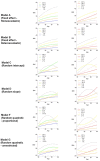Framework to construct and interpret latent class trajectory modelling
- PMID: 29982203
- PMCID: PMC6042544
- DOI: 10.1136/bmjopen-2017-020683
Framework to construct and interpret latent class trajectory modelling
Abstract
Objectives: Latent class trajectory modelling (LCTM) is a relatively new methodology in epidemiology to describe life-course exposures, which simplifies heterogeneous populations into homogeneous patterns or classes. However, for a given dataset, it is possible to derive scores of different models based on number of classes, model structure and trajectory property. Here, we rationalise a systematic framework to derive a 'core' favoured model.
Methods: We developed an eight-step framework: step 1: a scoping model; step 2: refining the number of classes; step 3: refining model structure (from fixed-effects through to a flexible random-effect specification); step 4: model adequacy assessment; step 5: graphical presentations; step 6: use of additional discrimination tools ('degree of separation'; Elsensohn's envelope of residual plots); step 7: clinical characterisation and plausibility; and step 8: sensitivity analysis. We illustrated these steps using data from the NIH-AARP cohort of repeated determinations of body mass index (BMI) at baseline (mean age: 62.5 years), and BMI derived by weight recall at ages 18, 35 and 50 years.
Results: From 288 993 participants, we derived a five-class model for each gender (men: 177 455; women: 111 538). From seven model structures, the favoured model was a proportional random quadratic structure (model F). Favourable properties were also noted for the unrestricted random quadratic structure (model G). However, class proportions varied considerably by model structure-concordance between models F and G were moderate (Cohen κ: men, 0.57; women, 0.65) but poor with other models. Model adequacy assessments, evaluations using discrimination tools, clinical plausibility and sensitivity analyses supported our model selection.
Conclusion: We propose a framework to construct and select a 'core' LCTM, which will facilitate generalisability of results in future studies.
Keywords: growth curves; growth mixture models; latent class models; lifetime obesity; trajectories.
© Article author(s) (or their employer(s) unless otherwise stated in the text of the article) 2018. All rights reserved. No commercial use is permitted unless otherwise expressly granted.
Conflict of interest statement
Competing interests: AGR has received lecture honoraria from Merck Serona and Janssen-Cilag and independent research funding from Novo Nordisk. All other authors have no conflicts of interest to declare.
Figures


References
-
- Lauby-Secretan B, Scoccianti C, Loomis D, et al. . and Cancer-Viewpoint of the IARC Working Group. Colditz G, Anderson AS, Herbert RA, Kaaks R, Thompson HJ, Baker JL, Breda J, Byers T, Cleary MP, Di Cesare M, Gapstur SM, Gunter M, Hursting SD, Leitzmann M, Ligibel J, Renehan A, Romieu I, Shimokawa I, Ulrich CM, Wade K, Weiderpass E. N Engl J Med 2016;375:794–8. - PMC - PubMed
MeSH terms
Grants and funding
LinkOut - more resources
Full Text Sources
Other Literature Sources
Medical
